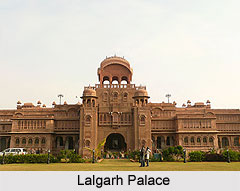 Lalgarh Palace is a royal palace in Bikaner in the Indian state of Rajasthan. It is an imposing red sand stone palace that was built by Maharaja Ganga Singh in the memory of his father, Maharaj Lal Singhji in 1902 A.D.
Lalgarh Palace is a royal palace in Bikaner in the Indian state of Rajasthan. It is an imposing red sand stone palace that was built by Maharaja Ganga Singh in the memory of his father, Maharaj Lal Singhji in 1902 A.D.
History of Lalgarh Palace
The Lalgarh Palace was planned and designed by the English Architect Samuel Swinton Jacob. It was built in between the years 1902 and 1926. The building was commissioned by the British controlled regency for Maharaja Ganga Singh. H.H. Karni Singh, M.P., the then Maharaja of Bikaner had established the Ganga Singhji Charitable Trust in 1972. A huge portion of the Lalgarh Palace was provided by the Maharaja for the use of the trust. Two wings were converted into independent hotels. Presently, the Lalgarh Palace is owned, and the hotel is run, by his daughter, H.H. Princess Rajyashree Kumari. Lord Curzon was the palace`s first notable guest. It has also been resided by Georges Clemenceau in 1920, Queen Mary, King George V, Lord Harding and Lord Irwin.
Architecture of Lalgarh Palace
The palace of Lalgarh reflects a beautiful blend of three different architectural styles, Rajput, Mughal and European can be categorized as Indo-Saracenic style. The palace has been built with red sandstone quarried from Thar Desert. The Rajput exterior of Lalgarh Palace stands as a glaring contrast with the occidental decor within. The majestic building has been adorned with overhanging balconies and sophisticated lattice work and filigree work. The three storied building with several grand halls, lounges, cupolas and pavilions exudes a classic beauty. The splendid drawing rooms, smoking rooms, guest suites, several grand halls, a dining room which could seat 400 diners, magnificent pillars, fireplaces, Italian colonnades and intricate lattice work adds to the beauty of the palace. The Karni Niwas wing has the darbar hall and an art deco indoor swimming pool. A carriage from Maharaja`s royal train is also noticeable here. The open corridors run the complete length of the halls and rooms. These have been decorated with rare collection of old prints and traditional beautiful paintings. The corridors linking with the rooms are mounted with hunting Trophies. The Palace is surrounded by lush green lawns with Bougainvillea bushes.
Lalgarh Palace presently houses a museum, Shree Sardul Musuem which is the fourth largest in the world. It showcases a wide collection of artefacts and personal belongings of Bikaner Maharaja. Few of the objects of interest found here are empty wine and sherry bottles; brass vessels known as tokna used to connect revenue in earlier days; an old film projector; personal belongings of Maharaja Karni Singh like golf tees, electric tooth brush, swimming goggles, earplugs and even his sneakers. The museum also has a huge collection of original Sanskrit manuscripts on parchments, copper and gold or silver plaques.
Lalgarh Palace as Heritage Hotel
A portion of the Lalgarh palace has been converted into a heritage hotel. It is managed by the famous ITC Welcom Heritage Group of Hotels. By staying here one can experience the royal grandeur of the yesteryears. The guests are welcomed with due respect in a traditional Indian style with a tika and aarti ceremony. The hotel offers 42 exotic rooms that have been decorated with period furniture, four poster beds, chaise lounges and exquisite carpets. At the dining hall the guests are served with traditional Indian, Continental and Chinese dishes. Rajasthani food is also provided. For the recreational facilities of the guests, light entertainment like Rajasthani folk performances and puppet shows are organised. There are also provisions for camel safari here.



















